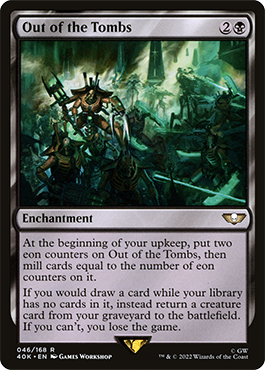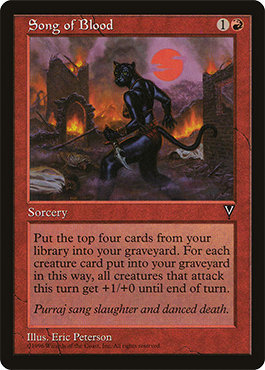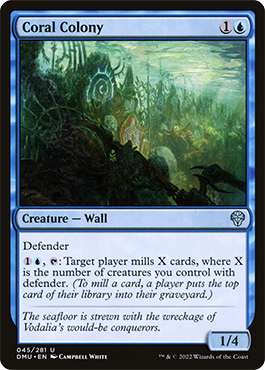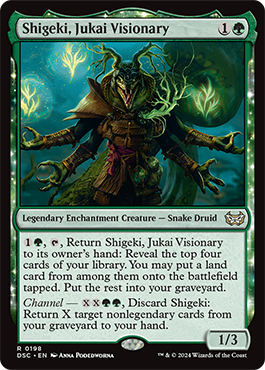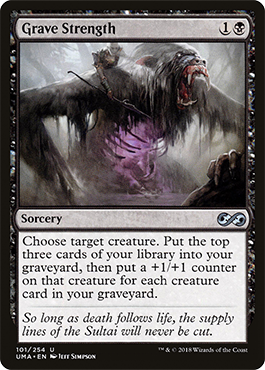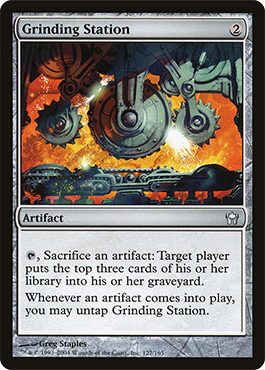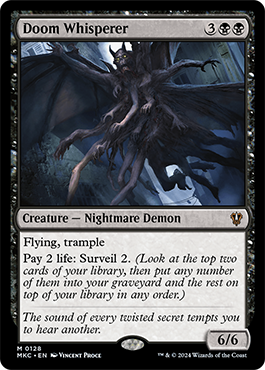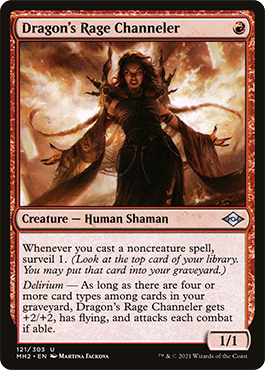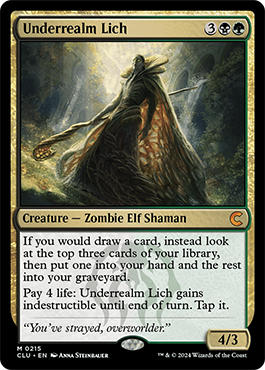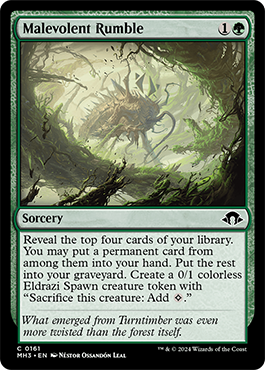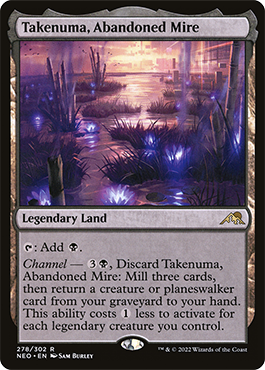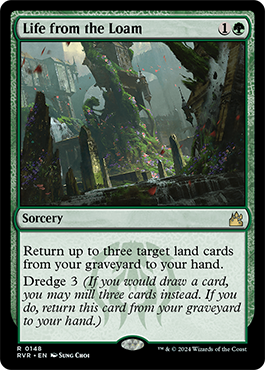Graveyard decks have always been a huge part of Magic, ever since the first Animate Dead was used to cheat out the first Lord of the Pit or Shivan Dragon. But if you broaden your definition beyond simple reanimation, almost every deck has some way to get value out of the yard – and if yours doesn’t, you’re probably not trying hard enough!
In formats with larger card pools, the graveyard zone often feels more like a second hand than a disposal area for used cards. It’s vulnerable to powerful counterplay through cards like Bojuka Bog or Endurance, but it also has a lot of advantages. One positive is that self-mill effects tend to be much cheaper than actual card draw, meaning you can access a larger chunk of your deck earlier in the game.
With spooky season upon us and Duskmourn: House of Horror getting players delirious for graveyards again, it seemed like an apt time to review some of the best “graveyard draw spells” in Magic history. How many of them are you running?
FAIR USE DISCLAIMER
As usual with these sorts of lists, I’m more interested in capturing an interesting cross-section of powerful spells than I am in choosing a strict definition of what makes one “best”. Some of these effects are good because they’re cheap; some are reusable; some have the potential to become wincons in their own right.
However I did draw a hard line around cards which primarily serve to mill your entire deck into your graveyard in one go: Hermit Druid, Cephalid Illusionist, Balustrade Spy, and so on. Those are arguably the “most powerful” mill spells, since in the right archetype they immediately lead to a combo win. But I’m looking for spells that you’d want to play across a wider variety of decks to help load up that other hand with value.
So, here’s twenty of the best “fair” self-mill effects in Magic history:
20. Out of the Tombs
Out of the Tombs earns a spot on this list as my slight favorite from a group of very similar cards (something which will also be true of several other entries). A repeating source of self-mill obviously has a higher potential impact than a one-off sorcery or ETB trigger. But waiting until the turn after you cast your three-mana spell to actually see results means these enchantments have a lot of catching up to do. Increasing the cards milled each turn is an attractive solution, creating a reliable one-card mill engine for any format. Even its second clause is worded in a very forgiving way, allowing for Out of the Tombs to be removed or cards to be shuffled back into the library with no ill effects.
19. Song of Blood
As a fan of go-wide decks, I enjoy keeping a mental inventory of obscure spells which can buff the power of your entire army for a competitive mana cost. Song of Blood is an ideal representative of this darling genre: +4 damage per attacker is an obscene amount of burst damage if you can fluke (or engineer) the best-case scenario. But even if you’re “settling” for a more reasonable +2 or +3, getting Trumpet Blast plus four self-mill in a two-mana package is nothing to scoff at. The fact you can see how big your bonus is going to be before deciding on attacks is a crucial distinction that makes me happy to play this alongside cards like Dreadhorde Arcanist and Claim // Fame.
18. Coral Colony
This slot should maybe have gone to Phenax, God of Deception, which especially as a commander has a much higher ceiling as a creature-based mill engine. But the steeper mana commitment, plus the fact Phenax technically does nothing on its own, locks it more into the role of build-around/win condition. Meanwhile Coral Colony (and the slightly inferior Doorkeeper) are much easier to work into various decklists as a nice blocker and mana-sink mill source. The tiny opportunity cost means you may not need a heavy defender theme to make Coral Colony viable, but it obviously helps – and also provides another way to kill opponents using Axebane Guardian + High Alert untap loops.
17. Shigeki, Jukai Visionary
One of my favorite Standard set designs from the last few years, Shigeki manages to encompass basically an entire gameplan in one card. You get an early game blocker which can absorb non-trampling hits while ramping your resources, just like his predecessor Sakura-Tribe Elder. But unlike his Elder, Shigeki can do this trick over and over again – and once you’ve milled and ramped enough, he can regrow all the best spells from your graveyard to help turn the corner. What’s even more amazing is how efficient every part of the card ends up being, to the point that the biggest weakness on Shigeki is a lack of haste. Remedy that with equipment or Concordant Crossroads, and you have a self-reliant (yet unselfish) one-card milling machine!
16. Otherworldly Gaze
If you count Surveil spells as self-mill (and I do, given how rarely you see triggers that care exactly how cards end up getting from your library to the graveyard), then Otherworldly Gaze is as good a choice as any for the most consistent, efficient, no-bells-and-whistles version of the effect. Not every entry on the list requires a lengthy explanation.
15. Angel of Suffering
On the opposite end of the scale, we have an incredibly expensive source of mill which then also requires external inputs to add even one card to your yard. What redeems this ominous angel for me is the combination of extremely high ceiling, relatively easy enabling condition and external utility. A graveyard-centric deck might not want to rely on this as its primary way to access cards. But it is still a handy source of mill which also has great impact defensively and as an enabler of certain other combos. One other subtle strength here is the degree of control you can have over exactly when cards are milled, and how many (assuming you have painlands or other unrestricted self-damage sources).
14. Grave Strength
Whenever a mill-cantrip type spell can tack on this kind of scaling benefit while keeping the mana cost low, it always seems like a pretty good trade – Drown in Filth could also be in this spot. But whereas the variable nature of the post-mill creature card count might cause that removal spell to miss, Grave Strength is a lot more forgiving – and has a bigger upside. The selling point of an effect like this is definitely the ceiling, and here the ceiling is a pre-combat trump card which produces lethal from far beyond the range your opponent expects for 1B.
13. Grinding Station
Did you know there’s only two cards in Magic with “Grinding” in the name, and they’re both mill spells? [EDITOR’S NOTE – here’s the other one, for the curious] Taking after the original Millstone and Grindstone, this artifact offers the perfect blend of simple enabler and combo-riffic payoff. The best part is that since you’re typically looking for ways to loop artifact cards out of your graveyard, targeting yourself with individual activations is an effective way to find the pieces of the eventual infinite! Even if you’re not trying to combo off, most Commander decks will have enough artifacts (either as delirium fodder or in token form) to give Grinding Station an impressive per-turn output.
12. Grolnok, the Omnivore
Magic has enough cards and mechanics that work from the graveyard to make self-milling a reward unto itself – but I won’t object to a mill engine that throws in something extra to sweeten the deal! Grolnok is everything you could want from a self-mill Commander in these colors: affordably costed, open-ended in deckbuilding requirements and templated to not lose its accrued value if removed. Well, you do have to get the frog back on the field to unlock the exiled spells again. But especially for a green deck that doesn’t seem like an unreasonable limit on its power. The 3/3 body is a tad small to risk regularly in combat, but you can always send your other Frogs (or changelings) to earn the trigger – or just use one of the other spells from this list…
11. Aftermath Analyst
Between the graveyard focus of Karlov Manor and Duskmourn and the raw power of Modern Horizons 3, 2024 has already contributed more self-milling tools than you’d expect from one calendar year. Aftermath Analyst is a half-step behind the truly best-in-class ETB creatures in terms of cards milled, but it’s still cheap to cast and has the many advantages of creature cards: attacking, blocking, ease of recursion, and so on. Still, what gets it onto this list is the secondary ability. Like Grinding Station, the potential of that ability alone elevates the Analyst from “nondescript bit player” to “combo win condition” – best showcased in a Constructed deck like Modern Amulet Titan, where the Analyst is looped to first access and then enable land-based combo kills.
10. Doom Whisperer
It might just be my unhealthy fandom for Doom Whisperer, but I think this Nightmare Demon is still underappreciated by a majority of players. Printed in the heady days of the “FIRE Design” power creep, you get a card which combines aggressively-costed stats with maybe the best draw-related activation this side of Griselbrand and Razaketh. It’s worth remembering that Surveil 2 is always a more-than-linear power jump from Surveil 1, since you’re able to leave a potentially critical spell on top while continuing to slide cards out from under it into your graveyard.
9. Dragon’s Rage Channeler
It says a lot about the power of graveyards that DRC is arguably the best one-drop in Modern Horizons 2… a set that also gave us Ragavan. The only reason “Darcy” isn’t higher up the list is because I’m rating her strictly as a self-mill engine. Getting a ton of free surveils while you charge up Delirium with Mishra’s Bauble is still exceptional value on a beatdown-focused creature. She’s just slightly better as card selection in a cantrip-heavy tempo deck than a more traditional Jund graveyard pile. I would recommend just playing her in everything.
8. Ashiok, Dream Render
This high up the list, you know that any of the more straightforward self-mill spells are grading out among the best value for mana you can get. Ashiok offers us a whopping 20 cards of self-mill for just three mana, AND simultaneously applies two brutal limitations to opposing decks. Normally you’d need to reach for your sideboard to get these kinds of hosers, but if you can get enough out of self-mill then you can make a strong argument for Ashiok ambushing foes out of the maindeck! The only question is whether you can keep them alive long enough to realize that value, given how desperate opponents will be to see them die…
7. Hedron Crab
Ever since it was printed, Hedron Crab has been the foundation of Constructed mill decks in any format with fetchlands. Just as Burn struggles to win with Lightning Bolt alone, you need a cheap creature that generates value over time in order to really maximize your mill count, and the Crab is simply best-in-class. Granted, those decks are almost all focused on milling out the opponent – but the original Hedron Crab is also able to target yourself, which makes it one of the most explosive and mana-efficient self-mill engines ever printed. Just make sure you bring your fetchlands if you’re not in blue-green.
6. Underrealm Lich
Self-mill is generally the first step in your gameplan, so it’s very impressive that a five-drop made it this high on the list. If you are looking for a bigger creature to fill your graveyard, you’d expect it to be able to add a lot of cards very quickly, like Doom Whisperer. But Underrealm Lich falls more into the Angel of Suffering mold: a card that can rack up some massive self-mill numbers quickly with the right enablers, and which will also do a lot else for you in the meantime. You just can’t over-rate replacement effects and card selection, especially on a body that’s easy to cheat into play and tricky to remove.
5. Malevolent Rumble
Malevolent Rumble may have been slightly overshadowed during Modern Horizons 2 spoiler season, but it has been showing up consistently since release in pretty much any deck that wants to load the yard fast. Getting to mill four and pick one back up for (effectively) just G is an amazing deal, and the fact you’re actually refunded that mana in the form of a flexible Eldrazi Spawn adds tons of fun utility. The only real downside is that it can’t retrieve cards that were in your graveyard already. But if you’re not playing a deck that relies on getting specific cards into hand, there might not be any real argument against this self-mill powerhouse.
4. Stitcher’s Supplier
We’re definitely down to splitting hairs over efficiency questions at this point on the list. Is it better to mill four cards and get one back for G, or to just mill six cards for B (with some help from a sacrifice outlet)? For me, the tipping point is in the card type – creatures are just much better than sorceries, adding the utility of attacking and blocking, paying sacrifice and convoke costs and everything else you need a body for in Magic. Creatures are also much easier to recur and reuse, which is obviously of great interest for any graveyard deck. All of this puts the little Zombie over the top as our best one-mana self-mill spell.
3. Say Its Name
As I explained in my Duskmourn Draft Guide, Say Its Name and Altanak work as a “draft puzzle” because both of them are just solid cards in their own right. In many ways, Say Its Name was what inspired me to write this list – just to test my hunch that it was close to a best-in-class self-mill spell. And in formats where exiling multiple copies to get a free 9/9 is possible, I would definitely trade that for the instant speed on Grapple with the Past. But even in Commander, the ability to get back any creature or land that was in your graveyard stands this creepy crawly summons in great stead.
2. Takenuma, Abandoned Mire
There’s a catchphrase in pro sports that says “the best ability is availability”. I would argue that the Magic equivalent is a low opportunity cost in deckbuilding, which is why good utility lands are always among the most played cards in Constructed. Even if Takenuma was a relatively bad mill spell, the fact you can play the first copy over a basic Swamp at almost no penalty to your manabase would get it into tons of lists. But it’s not a bad mill spell, or even a spell at all (great for dodging Thoughtseize and counterspells). It’s monocolor, instant speed, gets you back any previously-milled threat, and has some pretty significant interactions with other powerful spells – including the number one self-mill effect on our list…
1. Life from the Loam
As usual for these lists, the top spot ends up being rather predictable – but how do you go past the brokenness of Dredge when talking about best ways to load your graveyard? The mechanic saves you from really having to cast self-mill spells at all: you just mill a little to get them into your graveyard, then start replacing draws for free chunks of three, four, or five cards flipped over from library to grave.
I could have put down any Dredge card here. Or all of them. But Loam does stand a head above the rest in terms of versatility and utility across different archetypes, not least because it’s the easiest to get back into your graveyard each turn without a discard or sacrifice outlet. I don’t really need to explain more about how to use it – twenty years of tournament-winning Loam decklists should be sufficient testament to its top-tier power.
SELF-MILL ENGINE GO BRRRR
I think this list is one of the best examples of Magic’s astonishing depth, and how much context and nuance can impact your assessment of the “best” cards. Even for a relatively simple and un-interactive effect like self-mill, there are a dizzying number of ways to achieve it and all sorts of secondary considerations which might sway you towards one solution over another.
Do you need the lowest mana cost possible? What about the highest mill potential over time? Can you afford a card which relies on an outside enabler like a sac outlet or self-damage? How much milling efficiency would you give up for a shot at a zero-mana 9/9? Some of these questions might have “correct” answers, but I think they’re mostly up to the individual deckbuilder and the needs of their specific deck – which is of course what makes Magic deckbuilding such a joy. I hope you’ve enjoyed milli- I mean mulling over this list, and may your graveyards be ever full of value!

Tom’s fate was sealed in 7th grade when his friend lent him a pile of commons to play Magic. He quickly picked up Boros and Orzhov decks in Ravnica block and has remained a staunch white magician ever since. A fan of all Constructed formats, he enjoys studying the history of the tournament meta. He specializes in midrange decks, especially Death & Taxes and Martyr Proc. One day, he swears he will win an MCQ with Evershrike. Ask him how at @AWanderingBard, or watch him stream Magic at twitch.tv/TheWanderingBard.


